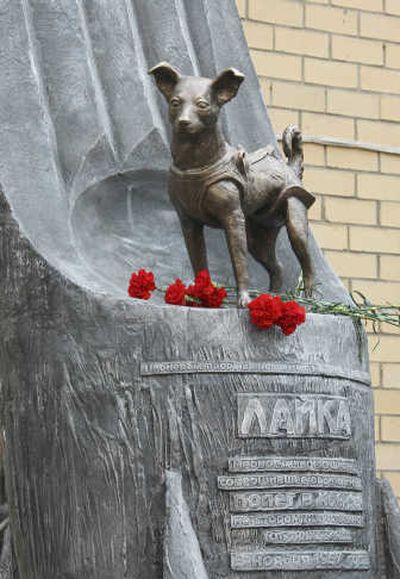Monument honors Laika, Russia’s first dog in space

MOSCOW – Russian officials on Friday unveiled a monument to Laika, a dog whose flight to space more than 50 years ago paved the way for human space missions.
The small monument is near a military research facility in Moscow that prepared Laika’s flight to space on Nov. 3, 1957. It features a dog standing on a rocket.
Little was known about the impact of spaceflight on living things at the time Laika’s mission was launched. Some believed they would be unable to survive the launch or the conditions of outer space, so Soviet space engineers viewed dogs’ flights as a necessary precursor to human missions.
All dogs used in the Soviet space program were stray mongrels – doctors believed they were able to adapt quicker to harsh conditions. All were small so they could fit into the tiny capsules.
The 2-year-old Laika was chosen for the flight nine days before the launch.
Stories about how she was selected varied: Some said Laika was chosen for her good looks – a Soviet space pioneer had to be photogenic. Others indicated the top choice for the mission was dropped because doctors took pity on her: Because there was no way to design a re-entry vehicle in time for the launch, the flight meant certain death.
“Laika was quiet and charming,” Dr. Vladimir Yazdovsky wrote in his book chronicling the story of Soviet space medicine. He recalled that before heading to the launchpad, he took the dog home to play with his children. “I wanted to do something nice for her: She had so little time left to live,” Yazdovsky said.
Because of last-minute technical problems, Laika had to wait for the launch in the cabin for three days.
When Laika reached orbit, doctors found with relief that her heartbeat, which had risen on launch, and her blood pressure were normal. She ate specially prepared food from a container.
According to official Soviet reports, the dog was euthanized after a week.
After the Soviet collapse, participants in the project told the real story: Laika indeed was to be euthanized with a programmed injection, but she apparently died of overheating after only a few hours in orbit.
Several other dogs died in failed launches before the successful spaceflight – and safe return to Earth – of the dogs Belka and Strelka in August 1960.
After a few other flights with dogs, the Soviet Union put the world’s first human – Yuri Gagarin – into space on April 12, 1961.